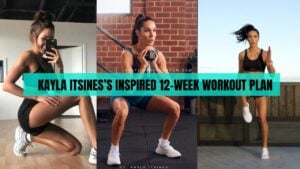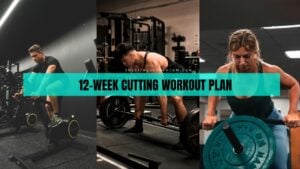The IYT raise is a compound exercise that bolsters the back and shoulder simultaneously and helps build an aesthetic and defined torso. However, it is also an underrated exercise because only a few people know about it, and very few of them actually do it.
I discovered IYT raises on the ACE Fitness website while searching for the best dumbbell back exercises (when I was a beginner).
I did this exercise every week (three to four sets of 8-10 reps) for 10 weeks to see its benefits. And I found it more effective than the other dumbbell exercises.
As I moved forward, I started customizing the I-Y-T exercise and exploring more variations of it.
After performing them all for a considerable period, I’ve decided to share all IYT raise variations, which muscles they target, and their benefits in this article.
Whether you train at home or the gym, you can integrate them into your training program to sculpt your upper body, particularly the shoulders and back.
The 6 Best IYT Raises Exercise Variations
- Incline IYT raises
- Floor IYT raises
- Seated I Y T raises
- Standing I-Y-T raises
- Dumbbell IYT Raises
- I-Y-T-W-O Raises
1. Incline I-Y-T Raises
Difficulty Level: Beginner to Intermediate
Muscles worked: Shoulders and Traps
The incline IYT raises targets the shoulders, rhomboids, and traps and helps develop a firm and upright trunk. You can do it with and without weight, depending on your fitness level and goal.
Steps to perform INCLINE I-Y-T RAISES:
- Lie on your stomach on an incline bench (30 to 45 degrees) with your chest on the edge of it.
- Extend your arms straight toward the ground with your palms facing each other, and lift your shoulder blades up a bit. That’s the start.
- Raise your arms before you until they are aligned with your shoulder. It’s an I raise.
- Return to the start, then raise your arms out at a 45-degree angle. That’s a Y raise.
- Lower your arms in the initial position, and then raise them entirely out to form a T raise.
- After a brief pause, return your arms to the beginning. That’s one rep. Do it as many reps as possible.
2. Lying IYT Raises
Difficulty Level: Beginner
Muscles worked: Back and Shoulders
The lying I Y T raises is an excellent bodyweight exercise to hit the back muscles without equipment. It requires you to lie prone on the floor and raise your arms in three different directions.
I still do this variation at home, especially in the morning, to provide good stretch and activation to my upper body muscles.
If you work out at home, let’s see how you can also do lying IYT raises step-by-step.
- Lie on the floor with your face down and arms straight against you.
- Brace your core, exhale, and lift your arms off the floor as high as possible. It’s I raise.
- Pause for two seconds, lower your arms back on the ground, and then raise them out at a 45-degree angle. That’s Y raise.
- Return your arms to the floor again and bring them to your sides.
- Lift your arms off the floor until your upper back is fully engaged.
- After a brief pause, return to the initial position and repeat all these steps to perform subsequent reps.
3. Seated IYT Raises
Difficulty Level: Beginner
Muscles worked: Shoulders
The seated IYT raises work on deltoids primarily and helps build firm and flexible shoulders at home without equipment.
Steps to perform a Seated I-Y-T raises:
- Sit on the edge of a bench with your feet firmly on the ground and arms at your sides.
- Raise your arms toward the ceiling until they are straight overhead (palms facing each other).
- Return to the initial position, then elevate your arms diagonally at a 45-degree until your fingers point toward the sky. That’s the Y raise.
- Pause for two seconds at the top, then return your arm to the start.
- Now, fly your arms out until they are parallel to the floor. That’s one rep.
4. Standing I-Y-T raises

The standing I-Y-T raise variation also engages abdominal muscles along with the back and shoulder and helps improve overall balance and posture.
Steps to perform a standing IYT raise:
- Stand upright with your feet about shoulder-width apart, arms extended at your sides, and palms facing your body. That’s the start.
- Brace your core and raise your arms toward the ceiling until they are straight over your head.
- Bring your arms back to the start, then raise them out at a 45-degree angle. It’s the Y raise.
- To follow the third step, lift your arms out to the sides until they are parallel to the ground.
- Pause for a few seconds, then return to the starting position.
5. Dumbbell IYT raises
The dumbbell IYT raise helps build muscle and improve the appearance of the upper body.
You can use dumbbells while doing seated, standing, and incline IYT raises variations.
You can do the seated and standing DB IYT raises on Shoulder day and incline IYT raises on the back workout day.
6. I-Y-T-W-O Raises
Difficulty Level: Intermediate
Muscles worked: Back, Shoulders, and Lower back
The I-Y-T-W-O involves multiple movements that target the latissimus dorsi, upper back, deltoids, rhomboids, and lower back and help improve upper body strength, flexibility, and posture.
You can also do it to activate your torso prior to lifting weights, such as bench press, overhead press, bent-over row, and deadlift.
Steps to do it:
- Set-up – Lie on your stomach with your arms straight over your head and palms facing the floor.
- I raise – Lift your arms off the floor as high as possible and lower them back.
- Y raise – Elevate your arms out at a 45-degree angle, then return to the start.
- T raise – Fly your arms out as high as possible, pause for a moment at the top, then return.
- W raise – Pull your arms, make a W shape with your torso, and raise it off the ground.
- O Raise – Grab your hands with one another above your lower back, brace your thigh and glutes, and lift your upper body as high as possible. After feeling the contraction at the top for two seconds, return to the start. That’s one rep.
IYT Raises Exercise Benefits
Here we take a look at the direct and indirect benefits of the IYT raises exercise:
1. Activate More Muscles
The IYT raise workout activates multiple muscles simultaneously, particularly the traps, deltoids, lats infraspinatus, erector spinae, and rhomboids.1 What Is the Best Back Exercise? American Council of Exercise It also enhances muscle coordination, and improves bone density, and helps develop a firm torso.
2. Improve Posture
The IYT exercises help develop a good posture by strengthening the upper body muscles.
Good posture helps keep your spine healthy and minimize spinal issues like herniated discs and chronic back pain.
Proper posture also helps evenly distribute the body weight and ease the strain on your muscles and joints, helps in avoiding muscle imbalances and reducing the risk of joint pain
3. Makes Your Torso Flexible
The IYTWO raises also make you flexible as it involves raising and stretching the muscles in multiple directions.
4. Adaptable
You can do IYT and its variations anywhere and anytime you want. All they require is your body weight and a little space to lie down.
5. Time-Efficient
The IYT raises are compound movements that help strike multiple muscle groups at once, giving you a decent workout in a short time. For example, you can perform floor IYT raises, which include Superman, reverse fly, and front raise, and all these movements help train back and shoulder simultaneously in less time.
Final Words
I-Y-T raise is a mix-up of multiple movements that make it one of the most effective upper-body exercises.
The “I” raises work on the front deltoid and upper trap, the “Y” raises engage lateral and posterior delts as well as the traps, while the “T” raises work on the rear delt and upper back.
The IYT raises can help you improve the shape of your torso and make it more flexible.
You can integrate all IYT variations into your resistance or bodyweight training program to make your workout interesting, challenging, and effective.
References
- 1What Is the Best Back Exercise? American Council of Exercise






